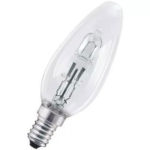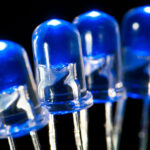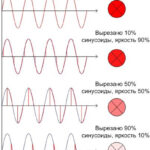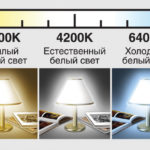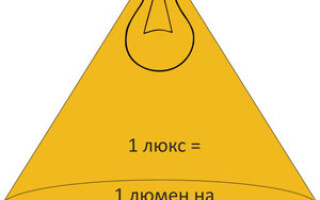Lumen is a unit of measurement of the brightness of radiation. It is an international system of units. Lumen describes the amount of light emitted by a source. It is a more accurate measure than power, because light sources with the same power but different efficiencies and spectral characteristics emit different light fluxes.
Contents
What is a lumen?
There are several units of measurement of illumination. The main values are lux and lumen. The difference between them is that lux shows illumination of a unit of surface area, while lumen is a unit of measurement of the whole radiation flux of a light source. So, the more the value of lux is, the brighter the surface is illuminated, and the more the lumen is, the brighter the luminaire itself is. This distinction helps to evaluate the effectiveness of lighting devices of different design.
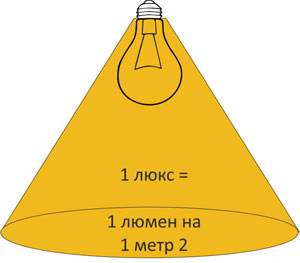
It is necessary to consider what are the lumens in LED lamps. This will help to understand the fact that such light sources are characterized by directional radiation. Incandescent and fluorescent emit light in all directions. In order to obtain the same surface illumination, LED elements of less brightness are needed, because the radiation is concentrated in one direction.
Incandescent and economy lamps emit radiation in a non-directional way, which requires reflectors (reflectors) to redirect the light in the desired direction. With LED devices there is no need for reflectors.
Parameters that determine the luminous flux indicator and its calculation
The parameters of illumination is affected not only by the brightness level of light sources. Should be taken into account:
- The wavelength of the light emitted. Illumination with a color temperature of 4200 K, which corresponds to the natural white color, is better perceived by the eye than illumination closer to the red or blue part of the spectrum.
- Direction of light propagation. Narrow-directional light fixtures allow you to concentrate the emission of light in the right place, without installing brighter fixtures.
Luminous flux in lumens is rarely specified by manufacturers, because most buyers are guided by the power of fixtures and their color temperature.
How many lumens in 1 watt LED bulb
Manufacturers of lighting equipment does not always put a complete list of characteristics on the product packaging. This may be for several reasons:
- The habit of buyers to evaluate the brightness of light bulbs by the power consumption;
- Unscrupulous manufacturers do not bother to conduct the necessary measurements.
The problem is that the emission level of LEDs and designs based on them are unequal:
- part of the flux is trapped by the protective bulb;
- in a LED lamp there are several LEDs;
- part of the power is dissipated at the LED driver;
- brightness depends on the amount of current through the LED.
Accurate determination is only possible with measuring instruments (lux meters), but for some types of LEDs can give approximate data:
- LEDs in a frosted bulb - 80-90 Lm/W;
- LEDs in transparent bulbs - 100-110 Lm/W;
- single light-emitting diodes - up to 150 Lm/W;
- experimental models - 220 Lm/W.
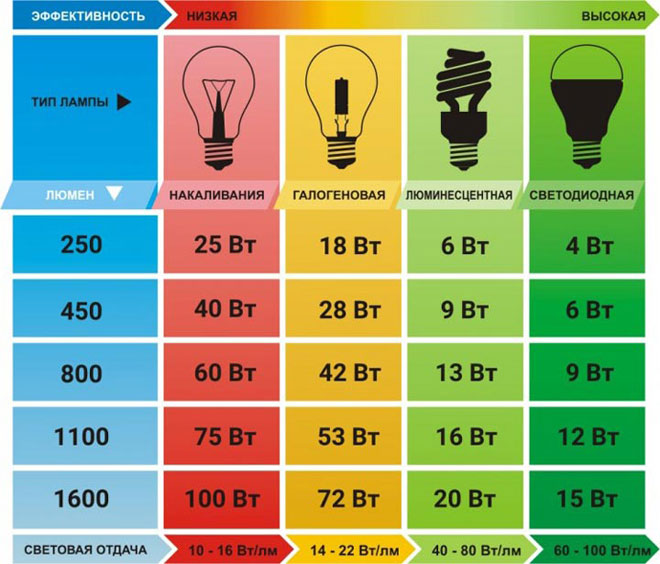
The listed data can be used to determine the current consumption when using LED devices, for which the value of brightness is determined. If an LED illuminator with transparent cover glass is installed and its brightness value is stated as 3000 lumens, then the power consumption will be 30 W. Knowing the power and supply voltage, it is easy to determine the current consumption.
Translation of lumens to watts
In order to compare the efficiency of different types of light sources and designs it is convenient to have in front of you a table which contains data about the power of light sources with the same brightness values.
| Luminance, Lumens per meter squared | LED bulb, W | Energy-saving lamp (fluorescent bulb), W | Incandescent Lamp, W |
| 250 | ~ 2 | ~ 5 | 20 |
| 400 | ~ 4 | ~ 10 | 40 |
| 700 | ~ 8 | ~ 15 | 60 |
| 900 | ~ 10 | ~ 18 | 75 |
| 1200 | ~ 12 | ~ 25 | 100 |
| 1800 | ~ 18 | ~ 40 | 150 |
| 2500 | ~ 25 | ~ 60 | 200 |
Dwelling space illuminance
The illumination of rooms for different purposes is not the same and can vary by an order of magnitude. The number of lumens per square meter by type of living space is as follows:
- office, library, workshop - 300;
- children's room - 200;
- kitchen, bedroom - 150;
- bathhouse, sauna, swimming pool - 100;
- checkroom, corridor - 75;
- hall, corridor, bathroom, toilet - 50;
- staircase, basement, attic - 20.
Calculation of illumination for the rooms
To determine the room illumination you need to know the following parameters:
- E - the normative value of illumination (how many lumens per 1 м²).
- S - area of the room.
- k - height factor:
- k = 1 for a ceiling height of 2.5 - 2.7 m;
- k = 1.2 for ceiling heights of 2.7 - 3.0 m;
- k = 1.5 for ceiling heights of 3.0 - 3.5 m;
- k = 2 for a ceiling height of 3.5 - 4.5 m;
The formula for calculation is simple:
F = E-S-k.
Knowing the illuminance, you can choose the required light flux and power of lighting lamps, taking into account their differences in technology of production and the principle of operation. You should take into account the peculiarities of human vision, for which light sources with a bluish tint (starting with a color temperature of 4700K and above) seems to be less bright.
Comparison of incandescent and LED lamps
Above there was a table comparing the power of different types of devices for the same brightness value. From the table you can see how many lumens in the incandescent, fluorescent and LED lamps.
The efficiency of the devices differ by more than an order of magnitude. It is immediately obvious that the comparison is in favor of modern light sources. And this is even without taking into account the great longevity of LED light sources. According to some manufacturers, the life of LED elements can be counted in tens of thousands of hours. The energy savings over the life of the product many times pays for the high cost of LED light sources.
100W incandescent bulbs are the most suitable for domestic lighting. Unsatisfactory efficiency, low life expectancy have led to incandescent light sources being displaced by more modern, efficient and long-lasting devices. A 12-watt LED bulb gives the same light flux as the lumens in a 100-watt incandescent bulb.
Related articles:


